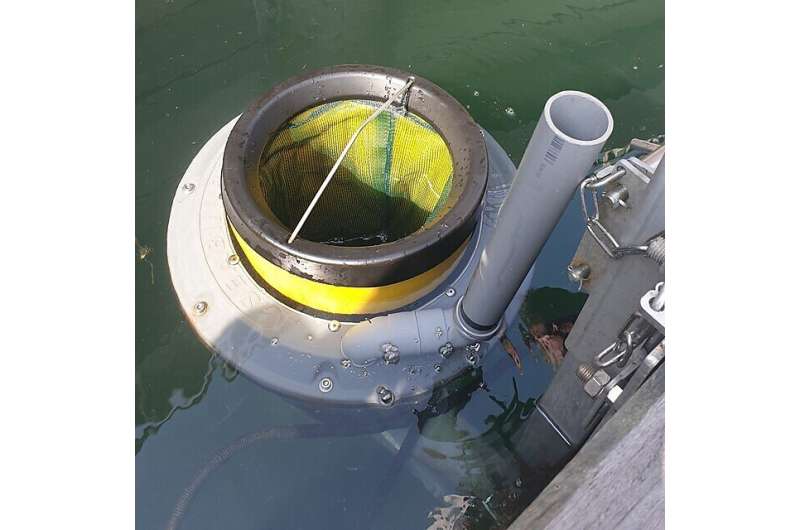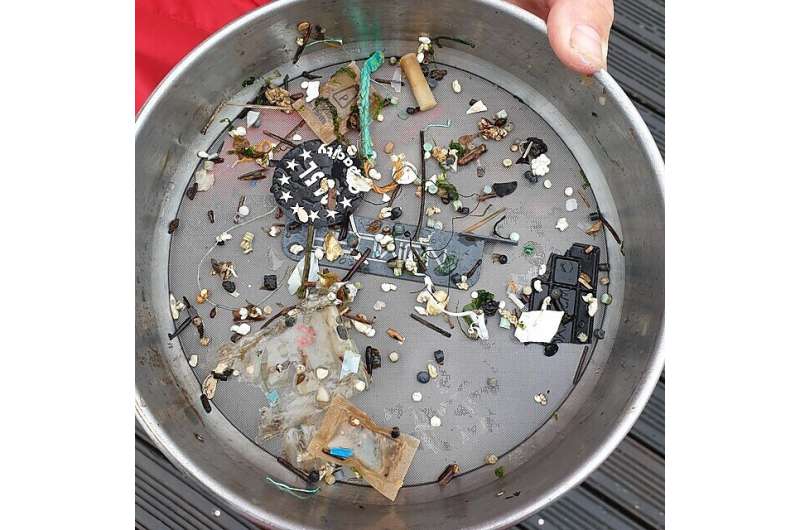Study explores the potential for mechanical devices to clear the ocean of plastics

Mechanical devices are increasingly being considered as a potential way to help address plastic pollution found globally in marine environments.
However, a new study suggests that while they do remove plastics and other items of marine litter, the quantities of litter removed can be comparatively low and they can also trap marine organisms.
The study was led by researchers from the International Marine Litter Research Unit at the University of Plymouth, who have been studying the issue of marine microplastics for more than two decades.
Their research was conducted in Plymouth (UK), and provides the first formal independent evaluation of the performance of a Seabin device.
The devices are designed to continuously suck water inwards using a submersible pump which is then filtered, and the cleaned water is returned to the surrounding area leaving the litter in the catch bag.
Hundreds have been installed globally and are reported to have captured over 2.5million kg of litter from calm sheltered environments such as marinas, ports, and yacht clubs.
This study found that a total of 1,828 items, 0.18kg of litter, was retained by the Plymouth device during 750 hours of operation between April and June 2021. This was equivalent to 58 items a day, and was mainly comprised of plastic pellets, polystyrene balls and plastic fragments.

However, the Seabin also captured one marine organism for every 3.6 items of litter, around 13 organisms a day including species such as sandeels, brown shrimp and crabs. Around 60% of those organisms were found to be dead upon retrieval, and the study indicates some organisms died after entering the device.
During the deployment, five manual trawls were conducted at the same marina using nets from pontoons or vessels. Manual cleaning collected an average of 19.3g of litter during cleans of up to five minutes. By comparison, the Seabin only captured the equivalent of 0.0059g in a similar timeframe.
Writing in the study, the researchers say that—based on their findings—the device was of minimal benefit in terms of marine litter removal in this particular location.
They also warn that the presence of such devices could also precipitate techno-optimism, a reliance on technological innovations, rather than systemic changes in our production, use, and disposal of plastics.
Florence Parker-Jurd, Research Assistant at the University of Plymouth and the study’s lead author, said: “At its current state of development, this study suggests that manual cleaning of ports, harbors and marinas, is more efficient and cost-effective. Notably manual cleans are selective, and this could lessen any potential risk to marine life. Given the increasing reliance on technological innovations, formal evaluations are necessary to their efficiency as similar may apply to other types of device.”
Professor Richard Thompson OBE, Head of the International Marine Litter Research Unit, added: “The UN Treaty to end plastic pollution presents an amazing opportunity to start to use plastics more responsibly, halting their accumulation in the environment. Ultimately, the best way to achieve that is by preventing the issue at its source rather than clean-up. However, The Treaty sets an urgent ambitious timeline and this could lead to increased investment in clean up as opposed to longer term systemic change. This study and others from my team highlight the critical importance of evidence to inform decisions about which type of intervention to invest in as we move to tackle this global environmental challenge.”
The full study—Parker-Jurd et al., Evaluating the performance of the ‘Seabin’—a fixed point mechanical litter removal device for sheltered waters—is published in Marine Pollution Bulletin.
Insect larvae may contribute to microplastic pollution in rivers by gnawing through litter, research suggests
Florence N.F. Parker-Jurd et al, Evaluating the performance of the ‘Seabin’—A fixed point mechanical litter removal device for sheltered waters, Marine Pollution Bulletin (2022). DOI: 10.1016/j.marpolbul.2022.114199
Citation:
Study explores the potential for mechanical devices to clear the ocean of plastics (2022, October 12)
retrieved 12 October 2022
from https://phys.org/news/2022-10-explores-potential-mechanical-devices-ocean.html
This document is subject to copyright. Apart from any fair dealing for the purpose of private study or research, no
part may be reproduced without the written permission. The content is provided for information purposes only.
For all the latest Science News Click Here
For the latest news and updates, follow us on Google News.

